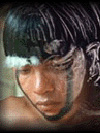Expedition To The Brazilian Amazon:
The Yanomami
My fellow explorers and I find ourselves along the Rio Branco in a bush pilot's office charting our prospective course into the Amazon upon a huge wall map of the state of Roraima in Brazil. We will be spending two weeks with the Yanomami people who inhabit the northeast region of Brazil and portions of adjoining Venezuela. The Yanomami's are the last major group of indigenous people still living interdependently within the Rainforest environment. They have lived in relative isolation from modern Brazil protected by the fact that the areas they inhabit are far from the major rivers that have served as highways since the time of Columbus.
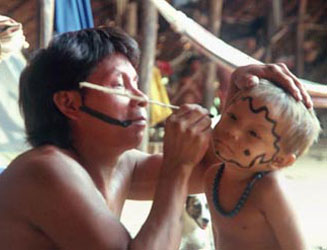
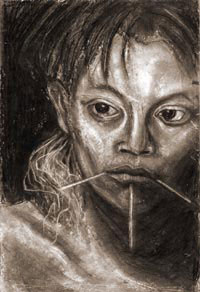
Soon we are on a small five-seater plane skating through air pockets leaving us all a bit nauseous. Below us the Rio Catramani's path snakes and shimmers, flashing bits of silver through an unending expanse of green. We pass over the tiny specks of the Catramani mission and a short while later, the health outpost, and finally the Yanomami village of Demini. Flying on for several minutes more the pilot circles the great round structure of a shabono that peers up at us like a giant eyeball staring from the unrelenting mass of vegetation of the jungle below. This shabono, a traditional thatched structure, is communal home to approximately seventy-five Yanomami. Just ahead, struggling up from the jungle's carpet, we can see the dark stone humped back mountains of the Serra Do Lua, which translates as the" Mountains of the Moon". A flock of eight Macaws screech past, their bright red and blue feathers streaking above our plane, which is now beginning to make its descent. The landing is bumpy as the wheels make contact with the ground and after a while our small party is on the runway blinking in the glare of the blazing morning sun. We all struggle to quickly transfer our gear to the cool shade of the outpost so as to escape the staggering heat. Soon we are greeted by a group of twenty or more of the Yanomami who have come to see the visitors.
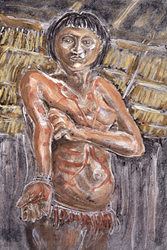
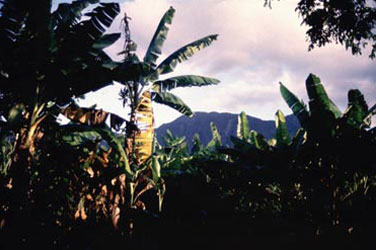
Someone in the group of Yanomami complains of a headache, another child has a fever and some of the medicine we have brought is distributed. The people surround us, curious as to who these new strangers are but all are still warm and open. A small girl approaches me and wraps her arms around mine. After a brief midday meal of beans and rice, we all head into the forest toward the shabono, which is an hour's walk away. The tangle of vegetation above our head shields us from the intensity of the fierce rays of the equatorial sun. Yanomami men, women and children of all sizes walk along side of us.
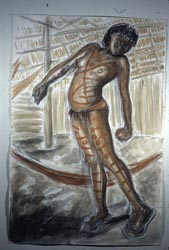
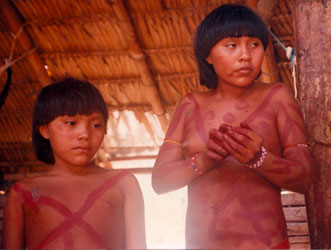
The same young girl that had earlier greeted me so warmly, now holds my hand in hers, leading me through the forest to her home. The sound of their language filters through the trees, mixing with the flip flopping of the many rubbers thongs, as we plod further into the forest. The women and young girls are wearing only woven red waist bands which are punctuated by long strings of brightly colored beads looped about their bodies. Their brown skin is stained with 'Urucu', a red stain collected from a plant and their ears are punctuated with feathers of iridescent greens and blues. The total effect is often completed by an array of flowers inserted into their ears, an interesting form of jewelry fresh from the jungle. Some of their mouths are adorned with thin sticks pushed through the skin, one in each corner of the mouth and the final one situated below the lower lip. Most of the younger men are sporting modern plastic flip flops and wear stylish brightly colored nylon shorts and swim trunks. This contemporary fashion does not deter many of the older males from retaining a more traditional garb, which is simply to tie up their penises with a string.
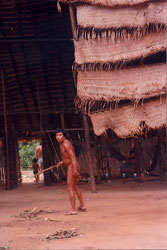
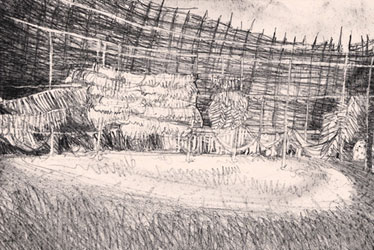
After a time, we reached an empty clearing that surrounded the shabono that we had seen from the air. I stooped down to enter through one of its tiny doors leaving the modern world behind me for one far more ancient. I was immediately greeted with the bustle of activity everywhere in the many family hearths underneath the shade of its large donut shaped roof. The heat of the wood smoke drifting up through the sunlit center 'eye' of the shabono seemed overwhelming. My own eyes began to tear and water uncontrollably and it became an effort to keep them open. Some people with a small child began to gather around my companion Jim and ask for medicine that he administered, pulverizing the tablet in a spoon and mixing it with a little water to give to the thin little girl. Her father said that her heart had been beating too fast and I had an immediate mental image of hummingbird wings.
It takes a while until my eyes adjust to the smoke so that I can once again see my surroundings clearly. There are huge piles of crisp fire blackened monkeys piled upon bright green banana fronds. Some of the men are busy putting them into knapsacks woven from the same banana leaves and are soon to leave for the river where the monkey carcasses will be washed. Their departure is signaled by whoops and shouts from those remaining behind. Two other men unfurl the bark of several slender tree lengths and spread this covering on the ground in preparation for the return of the freshly washed food. On their return the party begins to chop the monkeys on a long wooden log that had been laid along side the bark for that purpose. Their little bodies are first propped against the log and then neatly severed in halves and quarters. The young children peel small portions of the dry strips of meat to chew with the same sort of enthusiasm that other children show for candy.
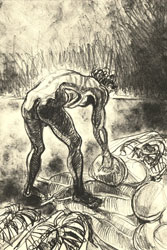
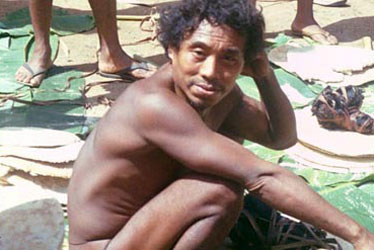
The residue that remains, primarily composed of plant debris, is quickly swept up and piled in a waiting basket and the center of the shabono is made ready for the festivities to come. Women are nestled about the fires fed by star shaped piles of logs which are slowly being devoured by the glowing embers. All the women are busy making the cassava bread by grating the manioc root into flour to fill a big basket. The coarse white ground flour is then expertly spread with a knife upon blackened round metal pieces that in turn are placed upon the top of smoky fires to cook.
An unexpected swift rain comes to splatter the dry sun stricken earth and relieves the intensity of the afternoon heat. The 'Tushua' or chief, Lorival, invites us to stay within the shabono so that we might be able to watch the dancing and ceremonies that are soon to be taking place. People from the neighboring Juricaba and Tootootobi villages, some three to eight days walk from here, are soon to arrive. We hasten back through the forest toward the post to gather our belongings to bring them back to the shabono to be in time for the evening's events. By the time we return, dusk is settling in and the natural 'stage' provided by the open center of the shabono is now darkening. Children flit in and out of its great circle involved in the pursuit of their endless games. The fires are glowing brighter now. Monkey meat is boiling in pots alongside flat metal trays of toasting cassava bread while the people chatter away to the accompaniment of barking dogs.
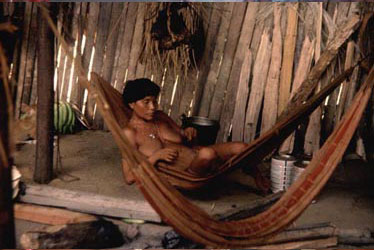
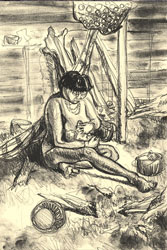
All are waiting for the dancing to begin and after a time it commences. It continues as we collapse into our hammocks exhausted from the day's exertions. At two o' clock in the morning, I awaken to find voices rising in sing song chants as shadowy bodies leap in and out of the darkness in an erratic but energetic ceremony. After a time, the men circle the inner circumference of the shabono in loose formation. The women bide their time occasionally tending the pots of slowly cooking food. Their turn at dancing will come later. I fall into a light sleep, my dreams intermingling with the resonance of chanting dancers rising and falling. Their writhing bodies in dark processions drift through my half consciousness.
Night once again slips into day. I have slept well despite the constant noise of a new world of constant activity that does not seem to distinguish day from night. This world seems to be beyond any clear cut division in terms of the time of day. My companion Decca, a nurse from the Macouxhi people, tells me that the women were too tired to dance the previous night but will do so today.
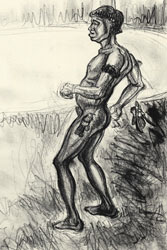
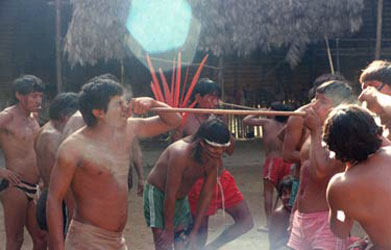
A small group of men are gathering to imbibe some 'ebene'. Breaking into pairs, one is loading the powdered 'ebene' into the end of a hollow shoot of bamboo. The drug is then in turn propelled through the tube that has been inserted into one of the nostrils of another man. In a single rapid exhalation of a deeply held breath, the first man creates enough compression to drive a great puff of ebene into the sinus cavity of the other. The force of the process is so great that it is driven out the his nostril. The cycle of loading the 'pipe' and blasting the drug into each others nostrils forming great stalactites of ebene and mucous that hang from the nose. The men become more animated in their gestures, chanting, yelping, stamping and uttering animal sounds. Their painted faces become utterly transformed as they swirl and streak past in unrestrained movement. What could seem as recreational drug use in another culture is in fact an elaborate ceremony where the imbiber is actually communicating with 'Hekura', the tiny spirits that live in their chests. Sometimes spirit warfare between tribes is conducted with this ritual rather than using weapons.
The next day the bones of a young boy that had died months before were retrieved so that mourners could participate in a ceremony that honors the dead. The bones of the boy have been burned and converted into a carbonized powdered and then mixed into a banana porridge that is subsequently shared by all who once knew him. The bananas have come from the boy's garden. Later that day the tree is chopped down never again to bear fruit. The memorial ceremony continues as a group of men form a circle. They crouch down within the larger circle of the shabono. An old visiting 'Shabori', or shaman, standing just above them is intensely chanting. The circle grows as other men join in the chanting and dancing. Then all rise 'en-masse' and whirl about, splitting into smaller and smaller groups like constellations of stars forming after the 'big bang'. Some of the mourners pair off and fall upon each other wailing and sobbing, their limbs loosely intertwined as they sit in the dirt. In another part of the shabono under the cover of the thatched roof a man uncomfortably straddles his hammock as five other Shabori screech forth collectively articulating a cure with their voices and bodies.
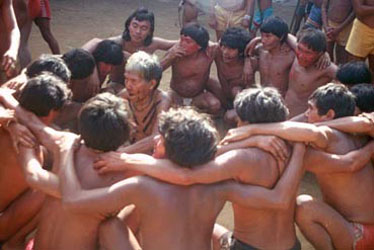
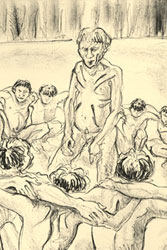
After the mourners have drifted away, another spectacle begins. Fresh banana leaves are laid about the middle of the shabono. Men approach from all directions bringing stacks of fresh cassava bread and place them on the leaves. Woven backpacks laden with monkey and tapir meat are also brought forth. The wealth is divided up amongst all, and the rightful portion is brought back to the hearth of each family. The family repacks the food, each into their own individual backpacks. This is the food that they will sustain them upon during their long hike back home. In the midst of every activity, children play and prance. Their mothers are involved in the daily practices of tending fires, cooking food, and suckling their infants.
The following morning, the Yanomani begin to paint themselves using big balls of red 'urucu' which is painstakingly collected from the seeds within little green pods. One woman squiggles bold red lines down another's legs, back and arms. She spits on the ball periodically as she twists it here and there on the flesh of her companion to make large red spots. The exact pattern varies depending on the artistic ability and whim of the person applying the pigment. Young girls decorate each other, small children draw on babies, husbands decorate their wives. One man caringly covers his wife's back with lovely undulating lines in counterpoint with large red dots. She continues this design on the front of her body lifting each breast to complete the design. Feathers are brought forth for the ears. Arm bands of tall Macaw feathers, necklaces with teeth, pods and rattling bills complete the adornment for many. Another celebration of life in the shabono begins.
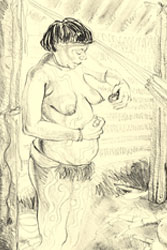
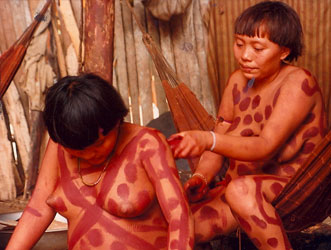
The artist wishes to dedicate this site to the Yanomami people who have extended their warmth and hospitality to her during her brief visits to their lands. Their way of life is in jeopardy of soon being extinguished by the relentless onslaught of the modern world in its ceaseless quest to reap the benefit of cheaper raw materials while showing an inability to respect any form of human culture that does not emulate its own form of materialism and greed. One can only wonder how long they can survive this invasion of their world and still remain themselves.


Soon we are on a small five-seater plane skating through air pockets leaving us all a bit nauseous. Below us the Rio Catramani's path snakes and shimmers, flashing bits of silver through an unending expanse of green. We pass over the tiny specks of the Catramani mission and a short while later, the health outpost, and finally the Yanomami village of Demini. Flying on for several minutes more the pilot circles the great round structure of a shabono that peers up at us like a giant eyeball staring from the unrelenting mass of vegetation of the jungle below. This shabono, a traditional thatched structure, is communal home to approximately seventy-five Yanomami. Just ahead, struggling up from the jungle's carpet, we can see the dark stone humped back mountains of the Serra Do Lua, which translates as the" Mountains of the Moon". A flock of eight Macaws screech past, their bright red and blue feathers streaking above our plane, which is now beginning to make its descent. The landing is bumpy as the wheels make contact with the ground and after a while our small party is on the runway blinking in the glare of the blazing morning sun. We all struggle to quickly transfer our gear to the cool shade of the outpost so as to escape the staggering heat. Soon we are greeted by a group of twenty or more of the Yanomami who have come to see the visitors.


Someone in the group of Yanomami complains of a headache, another child has a fever and some of the medicine we have brought is distributed. The people surround us, curious as to who these new strangers are but all are still warm and open. A small girl approaches me and wraps her arms around mine. After a brief midday meal of beans and rice, we all head into the forest toward the shabono, which is an hour's walk away. The tangle of vegetation above our head shields us from the intensity of the fierce rays of the equatorial sun. Yanomami men, women and children of all sizes walk along side of us.


The same young girl that had earlier greeted me so warmly, now holds my hand in hers, leading me through the forest to her home. The sound of their language filters through the trees, mixing with the flip flopping of the many rubbers thongs, as we plod further into the forest. The women and young girls are wearing only woven red waist bands which are punctuated by long strings of brightly colored beads looped about their bodies. Their brown skin is stained with 'Urucu', a red stain collected from a plant and their ears are punctuated with feathers of iridescent greens and blues. The total effect is often completed by an array of flowers inserted into their ears, an interesting form of jewelry fresh from the jungle. Some of their mouths are adorned with thin sticks pushed through the skin, one in each corner of the mouth and the final one situated below the lower lip. Most of the younger men are sporting modern plastic flip flops and wear stylish brightly colored nylon shorts and swim trunks. This contemporary fashion does not deter many of the older males from retaining a more traditional garb, which is simply to tie up their penises with a string.


After a time, we reached an empty clearing that surrounded the shabono that we had seen from the air. I stooped down to enter through one of its tiny doors leaving the modern world behind me for one far more ancient. I was immediately greeted with the bustle of activity everywhere in the many family hearths underneath the shade of its large donut shaped roof. The heat of the wood smoke drifting up through the sunlit center 'eye' of the shabono seemed overwhelming. My own eyes began to tear and water uncontrollably and it became an effort to keep them open. Some people with a small child began to gather around my companion Jim and ask for medicine that he administered, pulverizing the tablet in a spoon and mixing it with a little water to give to the thin little girl. Her father said that her heart had been beating too fast and I had an immediate mental image of hummingbird wings.
It takes a while until my eyes adjust to the smoke so that I can once again see my surroundings clearly. There are huge piles of crisp fire blackened monkeys piled upon bright green banana fronds. Some of the men are busy putting them into knapsacks woven from the same banana leaves and are soon to leave for the river where the monkey carcasses will be washed. Their departure is signaled by whoops and shouts from those remaining behind. Two other men unfurl the bark of several slender tree lengths and spread this covering on the ground in preparation for the return of the freshly washed food. On their return the party begins to chop the monkeys on a long wooden log that had been laid along side the bark for that purpose. Their little bodies are first propped against the log and then neatly severed in halves and quarters. The young children peel small portions of the dry strips of meat to chew with the same sort of enthusiasm that other children show for candy.


The residue that remains, primarily composed of plant debris, is quickly swept up and piled in a waiting basket and the center of the shabono is made ready for the festivities to come. Women are nestled about the fires fed by star shaped piles of logs which are slowly being devoured by the glowing embers. All the women are busy making the cassava bread by grating the manioc root into flour to fill a big basket. The coarse white ground flour is then expertly spread with a knife upon blackened round metal pieces that in turn are placed upon the top of smoky fires to cook.
An unexpected swift rain comes to splatter the dry sun stricken earth and relieves the intensity of the afternoon heat. The 'Tushua' or chief, Lorival, invites us to stay within the shabono so that we might be able to watch the dancing and ceremonies that are soon to be taking place. People from the neighboring Juricaba and Tootootobi villages, some three to eight days walk from here, are soon to arrive. We hasten back through the forest toward the post to gather our belongings to bring them back to the shabono to be in time for the evening's events. By the time we return, dusk is settling in and the natural 'stage' provided by the open center of the shabono is now darkening. Children flit in and out of its great circle involved in the pursuit of their endless games. The fires are glowing brighter now. Monkey meat is boiling in pots alongside flat metal trays of toasting cassava bread while the people chatter away to the accompaniment of barking dogs.


All are waiting for the dancing to begin and after a time it commences. It continues as we collapse into our hammocks exhausted from the day's exertions. At two o' clock in the morning, I awaken to find voices rising in sing song chants as shadowy bodies leap in and out of the darkness in an erratic but energetic ceremony. After a time, the men circle the inner circumference of the shabono in loose formation. The women bide their time occasionally tending the pots of slowly cooking food. Their turn at dancing will come later. I fall into a light sleep, my dreams intermingling with the resonance of chanting dancers rising and falling. Their writhing bodies in dark processions drift through my half consciousness.
Night once again slips into day. I have slept well despite the constant noise of a new world of constant activity that does not seem to distinguish day from night. This world seems to be beyond any clear cut division in terms of the time of day. My companion Decca, a nurse from the Macouxhi people, tells me that the women were too tired to dance the previous night but will do so today.


A small group of men are gathering to imbibe some 'ebene'. Breaking into pairs, one is loading the powdered 'ebene' into the end of a hollow shoot of bamboo. The drug is then in turn propelled through the tube that has been inserted into one of the nostrils of another man. In a single rapid exhalation of a deeply held breath, the first man creates enough compression to drive a great puff of ebene into the sinus cavity of the other. The force of the process is so great that it is driven out the his nostril. The cycle of loading the 'pipe' and blasting the drug into each others nostrils forming great stalactites of ebene and mucous that hang from the nose. The men become more animated in their gestures, chanting, yelping, stamping and uttering animal sounds. Their painted faces become utterly transformed as they swirl and streak past in unrestrained movement. What could seem as recreational drug use in another culture is in fact an elaborate ceremony where the imbiber is actually communicating with 'Hekura', the tiny spirits that live in their chests. Sometimes spirit warfare between tribes is conducted with this ritual rather than using weapons.
The next day the bones of a young boy that had died months before were retrieved so that mourners could participate in a ceremony that honors the dead. The bones of the boy have been burned and converted into a carbonized powdered and then mixed into a banana porridge that is subsequently shared by all who once knew him. The bananas have come from the boy's garden. Later that day the tree is chopped down never again to bear fruit. The memorial ceremony continues as a group of men form a circle. They crouch down within the larger circle of the shabono. An old visiting 'Shabori', or shaman, standing just above them is intensely chanting. The circle grows as other men join in the chanting and dancing. Then all rise 'en-masse' and whirl about, splitting into smaller and smaller groups like constellations of stars forming after the 'big bang'. Some of the mourners pair off and fall upon each other wailing and sobbing, their limbs loosely intertwined as they sit in the dirt. In another part of the shabono under the cover of the thatched roof a man uncomfortably straddles his hammock as five other Shabori screech forth collectively articulating a cure with their voices and bodies.


After the mourners have drifted away, another spectacle begins. Fresh banana leaves are laid about the middle of the shabono. Men approach from all directions bringing stacks of fresh cassava bread and place them on the leaves. Woven backpacks laden with monkey and tapir meat are also brought forth. The wealth is divided up amongst all, and the rightful portion is brought back to the hearth of each family. The family repacks the food, each into their own individual backpacks. This is the food that they will sustain them upon during their long hike back home. In the midst of every activity, children play and prance. Their mothers are involved in the daily practices of tending fires, cooking food, and suckling their infants.
The following morning, the Yanomani begin to paint themselves using big balls of red 'urucu' which is painstakingly collected from the seeds within little green pods. One woman squiggles bold red lines down another's legs, back and arms. She spits on the ball periodically as she twists it here and there on the flesh of her companion to make large red spots. The exact pattern varies depending on the artistic ability and whim of the person applying the pigment. Young girls decorate each other, small children draw on babies, husbands decorate their wives. One man caringly covers his wife's back with lovely undulating lines in counterpoint with large red dots. She continues this design on the front of her body lifting each breast to complete the design. Feathers are brought forth for the ears. Arm bands of tall Macaw feathers, necklaces with teeth, pods and rattling bills complete the adornment for many. Another celebration of life in the shabono begins.


The artist wishes to dedicate this site to the Yanomami people who have extended their warmth and hospitality to her during her brief visits to their lands. Their way of life is in jeopardy of soon being extinguished by the relentless onslaught of the modern world in its ceaseless quest to reap the benefit of cheaper raw materials while showing an inability to respect any form of human culture that does not emulate its own form of materialism and greed. One can only wonder how long they can survive this invasion of their world and still remain themselves.
